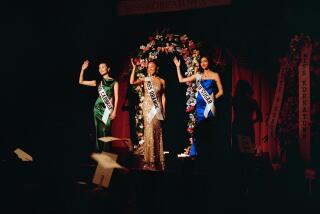A power shift in Koreatown
In Koreatown’s financial district, the ethnic niche isn’t so ethnic anymore.
The banks clustered along a mile-long stretch of Wilshire Boulevard still post signs in both Korean and English, and the tellers are bilingual. But the most competitive lenders have names like Bank of America Corp., Wells Fargo & Co., Credit Suisse and Lehman Bros.
“Now it’s Wall Street,” said David Lee, a physician and real estate investor who moved to Los Angeles from South Korea more than 30 years ago and owns dozens of office buildings in Koreatown.
As Korean Americans blend more and more into the social and economic scene, the big institutions that once shunned the mid-Wilshire area are increasingly eager to offer them loans.
That’s hurting the community banks that since the 1980s have catered to Korean Americans in Los Angeles.
The big four -- Hanmi Financial Corp., Nara Bancorp, Wilshire Bancorp Inc. and Center Financial Corp. -- have seen declines of 20% to 30% in their stock prices this year. They blame the influx of rivals for the sharp downturn in their results in the first quarter.
For Lee, one of L.A.’s biggest landlords, the situation makes sense. He can find financing from major national lenders in the 6% interest rate range, he said, and for 80% to 90% of the value of a building. By contrast, he said the Korean American banks, which historically have focused on smaller commercial real estate loans to customers without much credit history, might charge 7 1/2 % interest for a loan on 65% to 70% of a property’s value.
“As the Korean businesses got richer, they began to qualify for better financing,” Lee said.
For Christina S. Kim, a Newport Beach attorney born in South Korea, it isn’t so clear cut. She said Korean American banks provided better service and higher interest rates on savings. So her certificates of deposit are with Uniti Bank, a 6-year-old Korean American bank based in Buena Park that has full-service branches in Los Angeles and Garden Grove and lending offices in Temecula and Vienna, Va.
On the other hand, most of her professional and personal checking and trust accounts are with mainstream U.S. banks, including Bank of America and Wells Fargo & Co., because their many locations and financial products make them more convenient for her.
And when she purchased investment property -- an unusual Long Beach parcel with a small home behind a commercial building -- she shopped around and wound up with a loan from Pasadena-based East West Bank, the region’s largest Chinese American bank.
“American lenders are not flexible, and the property didn’t fit into their guidelines,” she said. East West “understood my situation better.”
Other Asian banks are encroaching, and there are more Korean American banks around these days too, with 14 going head-to-head in Southern California compared with four a decade ago.
But “the main competition is not so much Korean or even Chinese American banks but the mainstream banks,” said Sung Won Sohn, the chief executive at Hanmi Financial, the largest Korean American bank. “It’s BofA, Wells Fargo -- even European banks.”
Illustrating the sector’s recent rapid growth, Hanmi’s 2006 earnings were about four times larger than four years earlier. But then, on April 19, Hanmi set off alarm bells when it disclosed that its first-quarter profit would be as much as 30% lower than the previous quarter because of problematic loans.
“We downgraded the entire group that night,” said analyst James Abbott at Friedman, Billings, Ramsey & Co.
The big four also showed increasing problems with their loans in the quarter, suggesting to some analysts that they had responded to the competition by loosening lending standards. The banks denied any lapses in lending controls, calling their balance sheets fundamentally healthy.
They said the pressure on loan prices was a real problem, though, because the big conventional banks have so many consumer checking accounts and other sources of low-cost funds that they can undercut interest rates on loans.
What’s more, the banks’ dramatic expansion appeared to be slowing. Nara, for example, in the past had grown fast enough to compensate for shrinking profit margins on each loan, but recently, “loan productions fell somewhat short of our expectations,” the bank’s chief executive, Min J. Kim, told analysts.
Oppenheimer & Co. analyst Christopher Nolan said the four Korean American banks compared unfavorably with four California-based Chinese American banks and with a peer group Nolan created using six similar-sized mainstream community banks.
All four Korean American banks missed Wall Street’s earnings expectations last quarter, Nolan said, while all the Chinese American banks hit their numbers and four of the six mainstream community banks performed as expected.
Earnings per share for the Korean American banks fell 7% on average last quarter, while the Chinese American banks averaged 17% growth in per-share earnings and the mainstream community banks rose 9%.
Return on equity -- a measure of how well a business uses shareholders’ money -- had been in the 20% range for 2 1/2 years but dropped to 14% last quarter at the Korean American banks. And nonperforming assets -- loans no longer paying or 90 days delinquent -- doubled from a year earlier.
Officials at the banks cited a variety of problems they said would be resolved, including a borrower who missed a few payments while using insurance to repair a burned building, a Hurricane Katrina clean-up contractor the government was slow to pay and a hotel operator whose cash flow didn’t cover the mortgage but who was paying the loan out of his personal assets.
Despite classifying more loans as troubled or uncollectible and bolstering reserves for potential problems, the banks said actual losses would be small because the collateral on most of the loans remained strong.
Sohn, a former Wells Fargo economist who took the helm at Hanmi two years ago, said the Korean American banks “became darlings of Wall Street” by expanding their balance sheets at 20% to 40% a year during the 1990s and earlier this decade. Growth is now likely to remain below 20%, he said, “leading to lower expectations and stock prices.”
“The growth rate ... is what’s being reflected in the marketplace,” he said.
“If the economy really deteriorates, and if unemployment shoots up, then obviously it’s a whole different story. But we’re not there yet. I always said that [a bank’s] asset quality is as good as the economy the bank serves. And, you know, Southern California is performing pretty well.”
Analyst Abbott was skeptical, questioning how all four banks could report loan-related problems simultaneously and yet deny there was any fundamental problem in their business.
“I think it’s safe to say that right now there’s definitely a disconnect,”’ Abbott said. “We have not gotten to the bottom of it. Our clients and other investors are still questioning exactly what is going on.”
More to Read
Inside the business of entertainment
The Wide Shot brings you news, analysis and insights on everything from streaming wars to production — and what it all means for the future.
You may occasionally receive promotional content from the Los Angeles Times.











